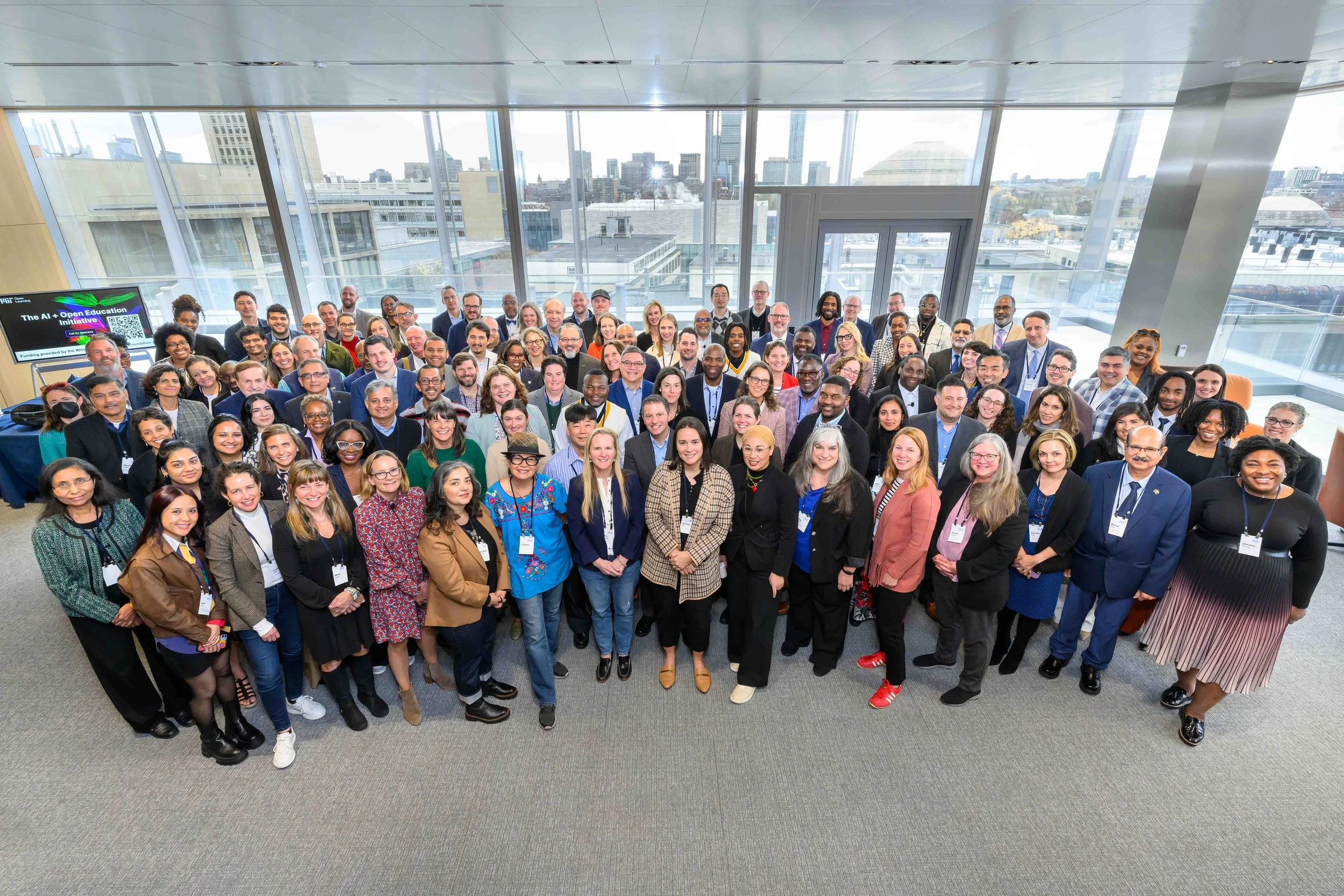AI & Education – From Access to Impact
AI & Education – From Access to Impact
In October 2024, Axim Collaborative, Complete College America, and Partnership for Education Advancement brought together higher education leaders and innovators to explore how artificial intelligence (AI) might be a tool that can help all students find their path to success.
There are many AI convenings these days, but this one was a little different. While the convening took place on the campuses of Harvard and MIT, it focused specifically on the use of AI in broad access higher education. The speakers and participants – including students – represented community college presidents, public university faculty members, historically Black college and university leaders, and innovators from minority-serving institutions. These broad access institutions educate a majority of U.S. students today. They will also be among the first to experience AI’s most significant impacts, both positive and negative.
Our goal was to foster conversations rather than presentations and to highlight practical applications – that solve real challenges for faculty and students today – instead of product pitches. Bharat Anand, Vice Provost for Advances in Learning at Harvard University, facilitated an interactive dinner discussion that engaged the entire group and surfaced themes that continued resonating over the next 1.5 days. The workshops on Day 2 had a spirit of collaborative problem-solving, where innovators shared their work in progress and received feedback from faculty members, college presidents, and students.
There was room for big ideas and for taking small steps. Makola M. Abdullah, president of Virginia State University, challenged the group with his opening statement that “the modern system of education that we have in this country will not survive AI.” Others highlighted the ways that AI can improve the current system, helping advisors better support their students, making course materials more interactive, and giving students new tools to develop their critical thinking skills. There was a lot of optimism about potential and an equal amount of realism that many institutions need more resources to fully participate.
Four specific threads emerged from the convening that Axim, alongside our network of partners, plans to incorporate into our future work. For a more comprehensive overview of the panels and discussions, you can find recordings of the talks and panels here and workshop descriptions and slides here.
Looking to the Future by Learning from the Past
While earlier waves of technological change allowed decades for adaptation, AI is transforming the job market almost in real time. This creates a sense of urgency. David Deming, the Isabelle and Scott Black professor of political economy at Harvard Kennedy School, explored in his opening talk how this current wave of AI innovations differs from previous technological shifts in both pace and scope. Although we don’t yet know which jobs AI will affect most, it has already eliminated the demand for some occupations that once represented an on-ramp into the labor market, like medical billing. Even openings for specialized jobs that traditionally ensured a secure path to economic security, like those in STEM, are down across the job market. Education institutions – particularly those serving students who are the first in their families to pursue higher education or who face financial challenges – must act now to preserve these important pathways for economic mobility.
Ensuring Everyone Can Participate and All Students Benefit
Although leading universities are already leveraging advanced AI tools, most higher education institutions don’t have access to AI tools or the resources needed to leverage them. That discrepancy risks widening existing inequalities in education, because students attending institutions with fewer resources may lack access to both AI-driven educational tools and career opportunities.
Chancellor John B. King Jr. of SUNY, reminded the audience of the limited impact that education technology has had on equitable outcomes and encouraged the group to do more. He highlighted the importance of focusing on student outcomes when designing or developing new innovations.
Equitable access to AI requires training, the opportunity for experimentation, and a seat at the table for students and other stakeholders. To reach broad access institutions, it is crucial that technology developers and companies tailor their solutions to the specific challenges and contexts of the institutions they hope to serve instead of proposing one-size-fits-all strategies built around elite universities.
Innovation efforts centered on the following themes can help align the benefits of AI with broad access higher education outcomes:
Create an “AI for Education” infrastructure that is freely available to all accredited institutions, which would create a level playing field. The National Artificial Intelligence Research Resource Pilot or state-sponsored efforts such as Empire AI in NY is a model example, but these initiatives focus primarily on research and not yet on end-user applications. There might also be an opportunity for more bottom-up approaches where networks of institutions collaborate directly to share expertise and resources.
Build communities of innovators within broad access institutions who collaborate, share successful solutions and resources, and coordinate around joint goals and objectives.
Produce AI-enhanced course materials in the most common courses to provide rich and useful feedback and adapt learning experiences to different backgrounds, cultural and language contexts, and existing (or missing) prerequisites. Such solutions could maintain rigorous academic standards while reshaping pedagogical practices and helping more students succeed.
Develop data-driven student support systems that can help focus existing human resources on those students most likely to benefit. Institutions can take a more active role in developing these systems by pooling data (while protecting student privacy) to improve AI models.
Augmenting Human Connection
Great learning and education involve meaningful human connections. In fact, the 2014 Gallup Purdue Index found that purposeful human interactions with a mentor or a professor who took a real interest in the student as a person was one of the strongest predictors of college having a lasting positive effect.
Axim Collaborative CEO Stephanie Khurana spoke about the importance of meaningful moments in education. She reminded the group of experiences we have had as students, where someone else connected with us and shaped our education, and interactions we have had as educators, helping a student imagine a future they may not have seen for themselves. All of these connections represent meaningful moments, and a good gauge of AI’s value in contributing to our ability to have even more meaningful moments over time.
As higher education leaders and innovators who care about our students above all, our goal for using AI in education should be to enhance human interaction – not replace it. When AI handles routine tasks like grading and scheduling, educators and advisors can focus on what matters most: meaningful engagement with students. By automating the mechanical, we free up time for the personal.
Taking Action Now
To realize the ambitious goals listed above, we need to form new types of collaborations between educational institutions, technology innovators, government agencies, and philanthropic partners. And to ensure the efforts stay focused on the right goals, student voices and experiences should guide our progress.
As AI rapidly transforms the economies and societies that will shape our students’ lives, we can’t afford to divide ourselves between those who believe in incremental improvement and those advocating for radical change of higher education. We need to explore both. By working together, we can develop AI that becomes a driver of educational equity rather than another wedge of division. There is no better way to end this post than with the final statement of the event by Chris Capozzola, Senior Associate Dean of Open Learning at MIT, who charged the group: “Let’s go to work!”
Contact
If any of the threads in this post resonate with you and your work and you would like to explore collaborating, please reach out to Philipp Schmidt VP Technology Innovation at ai@axim.org.





